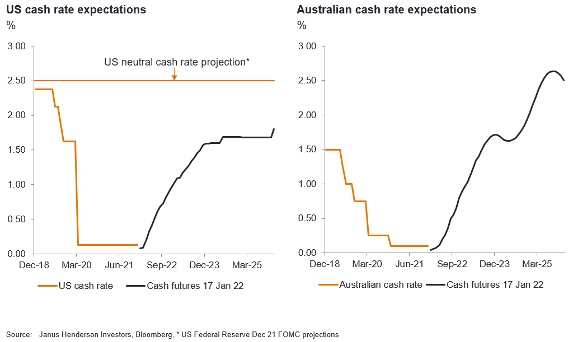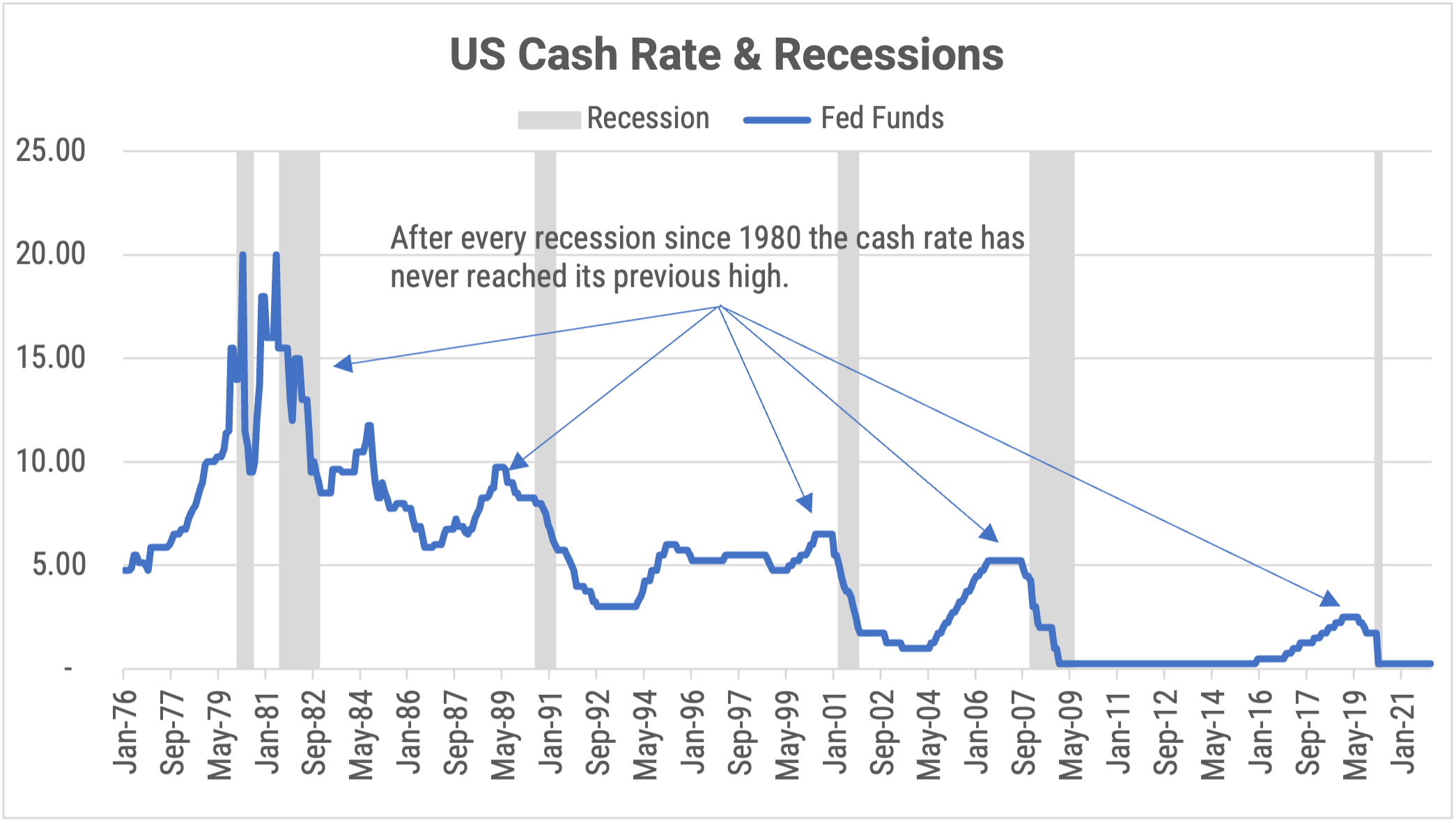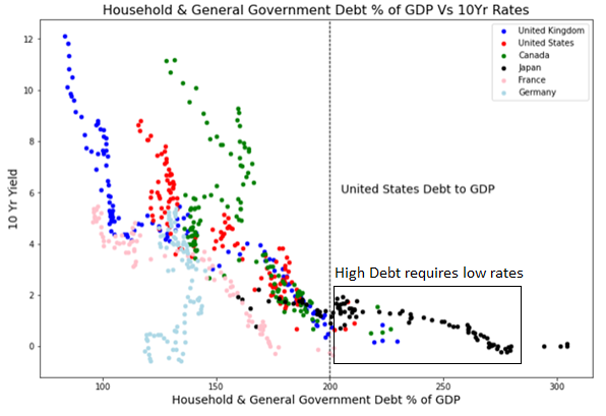What to expect when the ripples of US rate hikes reach our shores
Concerns that the U.S. Federal Reserve is behind the inflation curve intensified this week after rates were held at 0%-0.25%.
The market promptly threw the toys out of the cot when it found out. The Dow, which had been up about 600 points, finished the session down 100 points. This was despite explicit mention by the Fed that it plans to raise rates and taper its bond purchases.
“In light of the remarkable progress we’ve seen in the labor market and inflation that is well-above our 2% long-run goal, the economy no longer needs sustained high levels of monetary policy support,” Fed Chairman Jerome Powell said at a press conference.
“That is why we are phasing out our asset purchases...and we expect it will soon be appropriate to raise the target range for the federal funds rate."
Given the above, it's easy to deduce that the Fed is behind the eight-ball and inflation will continue its upward trajectory into the stratosphere.
But long-term investing requires sage analysis that cuts out exactly the kind of market noise we're currently being bombarded with. So we reached out to five experts to get their base case on rate hikes and quantitative easing, and how this timeline will impact Aussie investors.
Note: responses were collected prior to the Fed's January 27 announcement.
It's always darkest before dawn
Chris Siniakov, Franklin Templeton Investments
This current market environment feels like a ‘darkest before dawn’ experience. Our indicators tell us that the recent rise of US inflation to the latest lofty level of 7.0% y/y should not be naively projected higher into the 2022.
In 2020, governments around the world acted swiftly, stimulus and relief packages to support their economies. In the US (amongst others) some elements of these programs can be characterised as helicopter money. This is different to the QE 1, 2,3 & 4 programs in the post GFC period. This time around, Americans received direct deposits in their individual bank account from the $1.9 trillion American Rescue Plan Act of 2021, the $2.3 trillion Cares Act 2021 and the $0.9 trillion Consolidated Appropriations Act.
The resultant demand shock for goods, in the midst of substantial global supply chain challenges, has clearly translated to price pressures. However, the ‘bonus’ bank deposits have largely been spent and the expansionary fiscal impulse of 2020/2021 has already shifted to contractionary.
That is, the government fiscal impact on the economy is negative, providing a stiff headwind for economic growth and, ultimately, inflation.
The market is now projecting that the Federal Reserve will commence lift off for the official cash rate in March 2022. The market further projects that the official cash rate will end the year at 1.0%. Given the structural and cyclical (fiscal) headwinds discussed here, I expect the Fed will likely disappoint the market and be more measured in its policy tightening.
A first step on the long road back to 'normal'
Frank Uhlenbruch, Janus Henderson Investors
Our base case view is that conditions for lift-off have been met in the US. Inflation is well above target and the US Federal Reserve (Fed) does not see core inflation coming down to 2% until late 2024. They see labour market tightening, with the unemployment rate projected to settle at 3.5% over 2022-24, below their 4% long-run estimate. US growth is expected to slow from 4% in 2022 to 2% in 2024, above the Fed’s 1.8% long-run growth estimate.

Following recent commentary from a range of Fed officials, the first lift in the federal funds rate is likely to come in March and be followed up by three further moves this year.
Such a start to the tightening cycle signals intent and reduces the risk of a late, aggressive ‘catch up’ that could risk pushing the US economy into recession. We see the current tightening profile, which gradually takes the US cash rate up towards 2% by the end of 2025, as being reasonable. We agree that the Fed will gradually normalise the cash rate by taking it to the long-run rate, but no further.
History suggests the market is getting carried away
Chris Rands, Yarra Capital Management
While the inflation and unemployment outlooks suggest the Fed will hike rates, we believe the market is currently expecting too fast a path for the cash rate. After every recession since 1988 the cash rate has set a lower peak than the previous cycle, typically being anywhere from 1 to 3% lower than its prior high.
Given the large increases in debt since 2020, we think this same dynamic will play out with cash rate changes having a greater effect in the past in slowing growth and inflation. This would limit how high the cash rate can go.
Our expectation is that it will stop around the 1% range, which is below the market expectations of 1.50% and well below the 2.50% range which the Federal Reserves dot plot assumes.

Source: Bloomberg, YarraCM
A look at highly rated countries that have exceeded government and household debt to GDP of 200% over the past few decades shows why we hold this view. Once debt levels breach 200% to GDP, it becomes increasingly difficult to move rates.

Source: Bloomberg, Bank of International Settlements, YarraCM
Inflation is a moving target and the Fed will be flexible
Alexandre Ventelon, Morgan Stanley Wealth Management
Focusing again on the traditional relationship between US bond yields against key macro and market indicators, it would be easy to conclude the Fed is significantly behind the inflation curve. We believe this outcome can be explained by two key developments:
1) The Fed moving to average inflation targeting. This framework allows inflation to modestly and temporarily run above the target level to make up for past shortfalls, or vice versa. In addition, throughout the Covid-19 crisis, the Fed openly communicated the preference of making the mistake of too much stimulus versus too little. In particular, this has resulted in maintaining an overly dovish stance even after substantial progress was made on the employment side and inflation rose well above the Fed targets.
2) Until recently, the Fed has maintained the view that the spike in inflation was temporary and due to short term factors, and therefore not requiring an immediate and sharp hawkish turn. However, this view changed in the fourth quarter of last year with some core components showing signs of persistent longer term inflation trends such as wages.
To counter this stronger than expected inflation backdrop, Morgan Stanley believes the Fed will hike rates four times this year - in line with market expectations - and will also begin quantitative tightening in August.
Beyond this initial strong monetary response, we forecast only two rate hikes for 2023 given inflation will likely moderate amid a combination of significant investment in production capacity and moderating demand (especially on the goods side) which will bring relief to the supply/demand imbalances we witnessed throughout 2021.
Morgan Stanley also believes Fed rate hikes will be data dependent and investors shouldn’t take the central bank’s ‘dot plot’ as a hard commitment. The Fed has in recent years indicated its willingness to extend the business cycle for as long as possible, and will not be afraid to backtrack should the policy setting become too tight against the economic backdrop.
Expect a measured approach and tolerance for equity market pain
Kate Samranvedhya, Jamieson Coote Bonds
Jamieson Coote Bonds (JCB) base case expectation is that the Fed can announce the end of its asset purchase program in the FOMC meeting on 27 January 2022, then raise interest rates from March 2022 onwards. The market is fairly priced in for a 25 basis points hike per quarter already. The current debate is whether the Fed will hike by 50 basis points right away in March or look to hike at every meeting (every six weeks).
If we look back into history, the Fed cut rates by 50 basis points quite often but had only hiked rates by 50 basis points in 1994 and 1999 cycles. In 1994, the Fed started with three 25 basis-point hikes. Then, as economic growth continued its strength, the Fed decided that they were behind the curve and switched to 50-75 basis points per hike. The difference then and now is that the 1994 bond market did not price the hikes as much as it would today. The Fed’s communication strategy was also very different. In 2000, the Fed’s 50 basis point hike was the last hike of that cycle.
Many can remember the Dot Com bubble that year, so it may be of interest to know that by the time the Fed hiked rates by 50 basis points, the Nasdaq already sold off 30% from its peak.
It continued to sell off 30% more by year end before the Fed cut interest rates. This is a good reminder of how much the Fed tolerated negative equity market reactions back then.
JCB expects that the Fed can be more measured and raise interest rates by 25 basis points in March, then keep its options open to hike at every meeting without having to pre-commit to anything. The pace of hiking once a quarter came about after the Global Financial Crisis. Back then, the recovery was U-shape over many years; the Fed could afford to be patient, as things improved slowly. However, this cycle is different. We have a very strong V-shape recovery in both growth and inflation.
Implications down under
It's hard to know whether Australia will follow the Fed's lead or do its own thing.
On the one hand, Australia's data points don't lend themselves to rate hikes in the same way as they do in the US.
"The RBA has demonstrated previously that it has a strong resolve to do what is needed for the local economy," says Siniakov.
"From December 2016 to December 2018 the Federal Reserve raised the official cash rate eight times. The Bank of England and the Bank of Canada also increased their respective cash rates. By contrast, the official cash rate in Australia remained unchanged."
They will happen, though - markets are discounting a lift in the cash rate to 2.5% by late 2024 and close to 1% by the end of this year.
"The condition for lift-off in Australia (where incidentally the economy in Q3 2021 was only around the same size as it was at the end of 2019), remains for inflation to sustainably stay at around 2.5%," says Uhlenbruch.
For this, the labour market would need to tighten further and wages lift over 3%, which seems unlikely given current wage rigidities.
"Our view remains that policy normalisation is coming in Australia and that lift-off will begin in early 2023 and that the amount of tightening needed to get the cash rate back to neutral is not as high as the 2.5% currently priced in," adds Uhlenbruch.
That said, it could be a risk for the RBA to wait for these conditions to arrive.
"To wait for the first hike for a few more data points is to risk being behind the curve," says Samranvedhya, who suggests that the RBA could hike to 1-1.25%, then pause for a while to ensure the sustainability of inflation.
Then there's the argument that rising US bond yields will precipitate rate increases worldwide.
"US bond yields are considered the global benchmark in the sense that other Developed Market rates will generally follow their lead in terms of short-term direction," says Ventelon.
"In particular, we have seen how Australian government bonds have followed the trajectory of their US peers in spite of relatively lower inflation and a more dovish RBA."
He goes on: "The current outlook of substantial tightening in the US has generated a near exact translation in Australia (4.5 hikes expected in the next twelve months versus 4.2 respectively), although we only expect 4 hikes by the end of 2023."
Chris Rands from Yarra Capital Management agrees, pointing out that rate hike expectations in the US line up with those here in Australia.
"... despite the RBA’s attempts to tell the market that they will be patient our cash rate expectations are moving at the same pace as the US," he says.

Source: Bloomberg, YarraCM
A hawkish climate in the U.S. also has implications for Aussie equities.
"Interest rate hikes in the US, and the consequent rise in bond yields, reignite the ‘reflation trade’ which favours investments that are positively geared to the cycle and the associated yield curve steepening including the Value cohort, European equities, commodities as well as the financial and energy sectors," says according to Morgan Stanley's Alexandre Ventelon.
"We saw the reflation trade outperforming in similar conditions in the first quarter of last year. This is even more evident this year in the context of global markets currently ~3% lower (MSCI World Index), while the Global Value cohort remains in slight positive territory versus Growth ~8% lower."
Across the sectors, "financials and energy, remain strong global performers year to date (~2% and ~15% respectively) and to a lesser extent in Australia, while commodities remain strong with the GSCI Index posting gains of ~9% year to date."
Never miss an update
Enjoy this wire?
Hit the 'like' button to let us know. Stay up to date with my content by hitting the 'follow' button below and you'll be notified every time I post a wire.
1 topic
4 contributors mentioned

